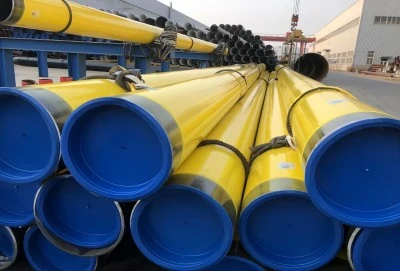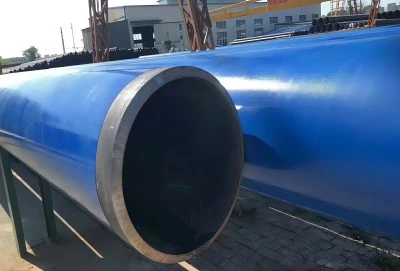Corrosion Protection
Fusion Bonded Epoxy (FBE) coating has become a cornerstone in the protection of FBE steel pipe, particularly in industries where corrosion resistance is paramount. The application of FBE coating to steel pipes offers a robust solution to the persistent challenge of corrosion, which can significantly impact the longevity and performance of pipelines.
Durability: FBE coatings provide exceptional resistance to corrosive environments, making them an ideal choice for pipelines that transport water, oil, gas, and other fluids. This durability stems from the unique properties of the epoxy material and the fusion bonding process. When applied correctly, FBE coatings can withstand harsh underground conditions, marine environments, and exposure to various chemicals without deteriorating. Studies have shown that FBE-coated pipes can maintain their integrity for decades, even in challenging conditions.
The durability of FBE coatings is further enhanced by their ability to resist cathodic disbondment. This property is crucial in environments where cathodic protection systems are used to prevent corrosion. FBE coatings maintain their adhesion to the steel surface even when subjected to the electrical currents used in cathodic protection, ensuring long-term corrosion resistance.
Barrier Function: The primary mechanism by which FBE coatings protect FBE steel pipes is through their barrier function. The epoxy coating forms a strong, continuous barrier that prevents moisture, oxygen, and other corrosive agents from reaching the steel surface. This barrier effect is achieved through the dense, cross-linked structure of the cured epoxy, which creates a physical obstacle to the diffusion of corrosive elements.
The effectiveness of this barrier function is closely related to the thickness and quality of the FBE coating. Typical FBE coatings range from 300 to 600 microns in thickness, providing a substantial shield against corrosive elements. The barrier properties of FBE coatings are further enhanced by their excellent resistance to water absorption and permeability, which helps maintain the integrity of the protective layer over time.
|
|
|
Adhesion
The effectiveness of any protective coating is heavily dependent on its ability to adhere to the substrate. In the case of FBE coatings on FBE steel pipes, adhesion plays a crucial role in ensuring long-term protection and performance.
Strong Bond: The fusion bonding process creates a strong mechanical bond between the epoxy and the steel surface. This process involves heating the steel pipe to temperatures typically ranging from 180°C to 250°C (356°F to 482°F) and then applying the epoxy powder electrostatically. The heat causes the epoxy particles to melt and flow, forming a continuous coating that chemically bonds with the steel surface as it cools and cures.
The strength of this bond is one of the key advantages of FBE coatings. The adhesion strength of properly applied FBE coatings can exceed 3000 psi (20.7 MPa), which is significantly higher than many other coating types. This strong adhesion ensures that the coating remains intact even under mechanical stress, such as during pipe installation or operation.
Surface Preparation: The quality of surface preparation is critical in achieving optimal adhesion of FBE coatings. Proper surface preparation ensures that the coating adheres well, maximizing its protective qualities. The process typically involves several steps:
Cleaning: The steel surface is thoroughly cleaned to remove any oil, grease, or other contaminants that could interfere with coating adhesion.
Abrasive Blasting: The surface is then subjected to abrasive blasting, usually with angular grit, to remove any rust, mill scale, or old coatings. This process also creates a surface profile that enhances coating adhesion.
Profile Measurement: The surface profile is measured to ensure it meets the specifications required for optimal FBE adhesion, typically between 50 to 100 microns (2 to 4 mils).
Dust Removal: Any remaining dust or debris is removed to ensure a clean surface for coating application.
Temperature Control: The steel is preheated to the required temperature just before coating application.
Each of these steps is crucial in ensuring that the FBE coating achieves maximum adhesion to the steel surface. Proper surface preparation not only enhances initial adhesion but also contributes to the long-term durability and performance of the coating.
Chemical Resistance
The chemical resistance of FBE coatings is a key factor in their widespread use across various industries. This property allows FBE-coated FBE steel pipes to maintain their integrity in diverse and challenging environments.
Variety of Conditions: FBE coatings demonstrate resistance to a wide range of chemicals, making them suitable for numerous industrial applications. This resistance extends to various pH levels, from acidic to alkaline environments, as well as to many organic solvents, hydrocarbons, and salts.
In the oil and gas industry, FBE coatings have shown excellent resistance to crude oil, natural gas, and various petrochemicals. In water and wastewater applications, they resist chlorides, sulfates, and other corrosive elements commonly found in these systems. The chemical resistance of FBE coatings also makes them suitable for use in chemical processing plants, where pipes may be exposed to a variety of aggressive substances.
It's important to note that while FBE coatings offer broad chemical resistance, their performance can vary depending on the specific chemical exposure, concentration, and temperature. For particularly aggressive chemical environments, specialized FBE formulations or multi-layer coating systems may be employed to provide enhanced protection.
Long-term Stability: One of the most valuable attributes of FBE coatings is their ability to maintain their protective properties in harsh environments over extended periods. Unlike some other coating types that may degrade quickly when exposed to certain chemicals, FBE coatings exhibit remarkable long-term stability.
This stability is attributed to the highly cross-linked structure of the cured epoxy coating. The dense network of chemical bonds in the epoxy matrix resists penetration and degradation by many chemical species. As a result, FBE-coated pipes can maintain their protective barrier for decades, even when continually exposed to corrosive fluids or soil conditions.
The long-term chemical resistance of FBE coatings translates to reduced maintenance requirements and extended service life for steel pipes. This durability not only provides economic benefits in terms of reduced replacement and repair costs but also enhances the overall reliability and safety of pipeline systems.
Contact Longma
When selecting an FBE steel pipe manufacturer, quality and reliability are essential. LONGMA GROUP specializes in FBE steel pipe coating, adhering to industry standards that ensure excellent corrosion protection, strong adhesion, and chemical resistance. Their expertise guarantees that the FBE coating meets specifications for critical pipeline projects. If you're looking for a manufacturer, contact LONGMA GROUP at info@longma-group.com for detailed information on their FBE coating process, quality control measures, and product offerings tailored to your project needs.














